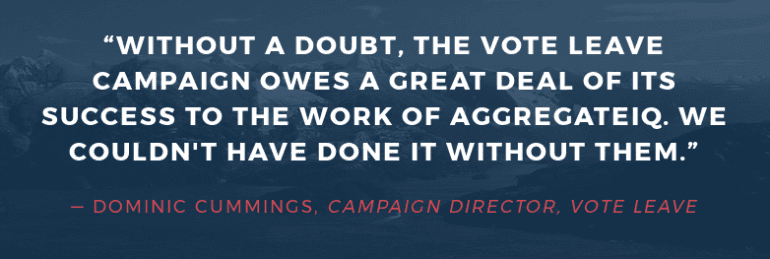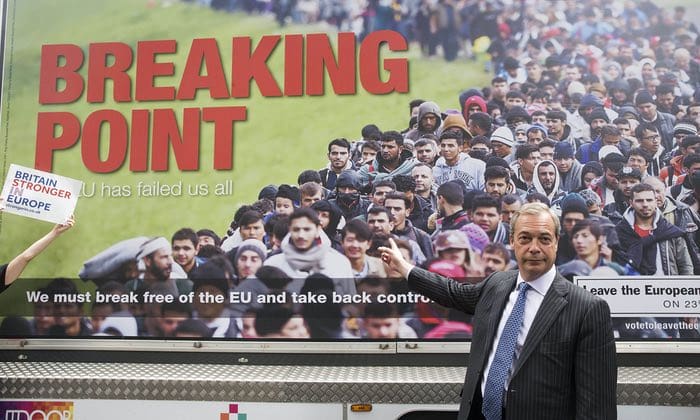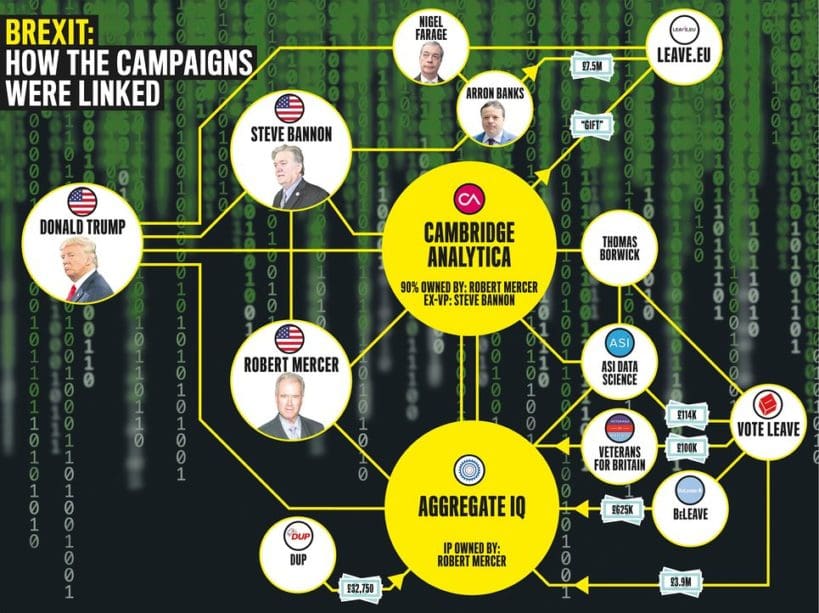The days when informed voting simply meant watching the party political broadcasts or scrutinising party manifestos are long gone. These days there is a multi-million pound industry that specialises in managing voter behaviour. This is achieved through a combination of data-harvesting and the application of algorithms. Or even via military-style ‘psychological operations‘. Britain’s 2016 EU referendum was a classic example of how this form of electoral subversion occurs.
Previously The Canary reported the links between Britain’s pro-Brexit campaigns and associates of US President Donald Trump. As well as the subsequent investigations by statutory bodies into those links and possible undeclared spends. The Canary also alleged that US-based technology agencies used or advised on behavioural management technologies to ensure a Brexit win.
But there is far more to these revelations. Moreover, voter manipulation could become a feature of all elections.
It’s all about maths
Vote Leave, the campaign backed by Tory MPs Boris Johnson and Michael Gove, had its own campaign software. This is known as VICS, or Voter Intention Collection System. It was used to upload sophisticated data models, which predict where Leave voters were likely to be, so that canvassing efforts can be better focused.
Basically, it’s all about maths. And according to Vote Leave campaign director Dominic Cummings, the 2016 EU referendum can be summed up as follows:
Changing the course of European history via the referendum only involved about 10 crucial people controlling ~£107 while its effects over ten years could be on the scale of ~108 – 109 people and ~£1012
These calculations are explained [pdf] in more detail. And on page 11 of the document Cummings provides a breakdown of how social media was used in terms of emails, tweets and texts.
Manipulating social media
In the same document the full costs of the Vote Leave campaign are given (page 5):
…about £13.6m between Summer 2015 and closing of VL in July 2016, with nearly £7m of ‘controlled’ expenditure (the legal limit for the 10 week campaign) plus £6.6m of non-controlled expenditure. Of this £6.6m, £3.3m was incurred during the 10 week official campaign…
And a more detailed breakdown is given on page 5, with the biggest proportion (25%) of spend shown as social media advertising.
Cummings also breaks down (page 12) the $3.6m spent on the social media campaign, organised by the Canadian-based technology firm Aggregate IQ (AIQ). Most of that money was spent on Facebook.
A total (page 12) of 309 million online ads were run by Vote Leave in the ten week campaign and (page 14) 890 million from October 2015.
Targeting the ‘persuadables’
Cummings sums up (page 15) the overall spend:
We focused most of this money on the last 10 days and on about 9 million ‘persuadables’ – not our core voters – identified by the data science team from a variety of sources with a variety of methods some very simple and some very sophisticated. That group was on the receiving end of a barrage of £350m/NHS/Turkey mostly in a small time window.
The other interesting statistic (page 6) is the proportion of UKIP/Tory coordinators in target constituencies. A massive 90% indicates what could be seen as a symbiotic relationship between the two parties.

The subversion of social media
One of the key players in the voter behaviour industry is SCL.
Dr Aleksandr Kogan, a lecturer at Cambridge University first introduced the London firm to the idea of using social media data to model human personality traits. Kogan used Amazon’s crowdsourcing marketplace Mechanical Turk (MTurk) to access a large pool of Facebook profiles. This saw the hoovering of tens of thousands of individuals’ demographic data, as well as Facebook “likes”. That data was later used commercially by SCL, which allegedly crawled the profiles of friends of the Facebook users.
‘Emotional triggers’
An offshoot of SCL is the US-based Cambridge Analytica (CA), CA is a pioneer of social media exploitation. It specialises in “behavioural change” technologies (like artificial intelligence and psychometrics). CA later went on to test aspects of these technologies for the Ted Cruz campaign via its Cruz Crew app.
:
[CA]…will be helping us map the British electorate and what they believe in, enabling us to better engage with voters… Cambridge Analytica’s psychographic methodology however is on another level of sophistication.
The exploitation of behavioural or ‘emotional triggers‘, such as images of migrants ‘swamping’ the country, is one of the behavioural management techniques used by SCL/CA:

A tangled web
Billionaire Trump supporter Robert Mercer is a financial backer of CA. Mercer is not only Trump’s main financial backer but also funds Breitbart News. And former Breitbart Executive Chairman Steve Bannon (a prominent Trump confidante) is a board member of CA. So it’s no surprise that Donald Trump’s presidential campaign team paid CA more than $5m to help elect him.
Interestingly, AIQ’s intellectual property (IP) is owned by Mercer. And Chris Wylie, an associate of AIQ, reportedly introduced data and behavioural microtargeting techniques to CA (and SCL). Indeed, according to whistleblower and former CA staffer ‘David’, AIQ built and ran CA’s database platforms.
Moreover, Thomas Borwick, a former consultant for CA and SCL, just happens to have been the chief technology officer for Vote Leave.
The Canary has previously published details of the links between the Brexit campaigns and associates of US president Trump. These links are summarised in this diagram by The Guardian:

The web gets wider
There is an even bigger player in this industry.
Reportedly, Sophie Schmidt advised SCL head Alexander Nix to check out the work of US data intelligence agency Palantir Technologies. Schmidt, the daughter of Google chairman Eric Schmidt, used to work for SCL Elections (which was later renamed Cambridge Analytica).
Palantir is chaired by billionaire and Paypal founder Peter Thiel, who is also a board member and major investor of Facebook. Earlier this year Thiel joined Trump’s transition team.
Apparently, Palantir has contracts to handle vast data sets on UK citizens for British spy agency GCHQ, as well as US citizens for the NSA. In addition, Palantir has developed an aid for the spyware XKEYSCORE programme, used by the NSA and its ‘Five Eyes‘ partners and subsequently exposed by whistleblower Edward Snowden. Such spyware could be useful for garnering consumer data, including, no doubt, voter lifestyle preferences.
A confidential GCHQ report shows that it was first introduced to Palantir in 2008. And a 2010 presentation on the joint NSA-GCHQ ‘Mastering the Internet‘ surveillance program recommended running Palantir software on Android handsets (smartphones and tablets).
(As an aside, it is interesting to note that Palantir was under investigation by US journalist Barrett Brown, immediately prior to his arrest and imprisonment. Brown found that Palantir, HBGary Federal (later rebranded as CounterTack) and Berico were part of a dirty tricks campaign [pdf] to discredit WikiLeaks’ editor-in-chief Julian Assange and Intercept editor Glenn Greenwald. Palantir was also involved in a plot to undermine the political opponents of the US Chamber of Commerce.)
Democracy questioned
New York University associate professor Tamsin Shaw sums up the application of voter behaviour technologies:
This is military-funded technology that has been harnessed by a global plutocracy and is being used to sway elections in ways that people can’t even see, don’t even realise is happening to them. It’s about exploiting [an] existing phenomenon like nationalism and then using it to manipulate people at the margins.
Thus simple yes/no voting, such as with the EU referendum, is particularly susceptible to this kind of interference. Or as Leave.EU financier Arron Banks succinctly puts it:
interesting,since we deployed this technology in leave.eu we got unprecedented levels of engagement. 1 video 13m views. AI won it for leave https://t.co/mlB3TSyrSk
— Arron Banks (@Arron_banks) January 30, 2017
Meanwhile, the Electoral Commission is looking into [paywall] possible undeclared spending by Vote Leave and possible ‘in-kind’ work by CA for the Leave.EU campaign.
But this is not simply about overspends, or the contracting of foreign-based companies to influence voter behaviour. It’s far more fundamental: the subversion of how we participate as citizens in a democracy, flawed as it is. For the voting electorate, like the peasants of old, is merely seen as a group of pawns to exploit.
Get Involved!
– Read more about investigations into the Brexit campaigns here, here, here and here.
– Read about investigations into allegations of Tory election fraud.
















